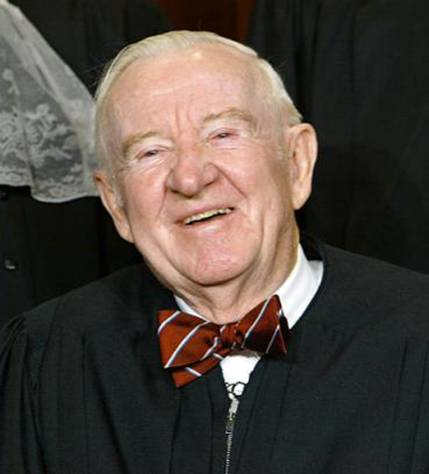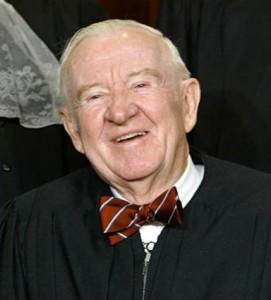Justice John Paul Stevens made a difference in your life

Justice John Paul Stevens retired when the latest session of the U. S. Supreme Court ended in June, 2010. After 35 years on the Court and nearly 90 years old, Stevens will leave a legacy summed up in Newsweek (April 19, 2010) as: “It was an 89 year old white Protestant guy who devoted his career to standing in the shoes of teenage schoolgirls and gay Boy Scout leaders.”
Stevens was appointed in 1975 by President Gerald R. Ford. He participated in a number of education cases and wrote a few majority opinions that are summarized below.
 In a 1985 case, New Jersey v. T.L.O., Stevens dissented from the court’s decision upholding a search by a high school vice-principal of T.L.O’s purse, which turned up marijuana. He wrote as follows: “The schoolroom is the first opportunity most citizens have to experience the power of government. Through it passes every citizen and public official, from schoolteachers to policemen and prison guards. The values they learn there, they take with them in life. One of our most cherished ideals is the one contained in the Fourth Amendment: that the government may not intrude on the personal privacy of its citizens without a warrant or compelling circumstance.”
In a 1985 case, New Jersey v. T.L.O., Stevens dissented from the court’s decision upholding a search by a high school vice-principal of T.L.O’s purse, which turned up marijuana. He wrote as follows: “The schoolroom is the first opportunity most citizens have to experience the power of government. Through it passes every citizen and public official, from schoolteachers to policemen and prison guards. The values they learn there, they take with them in life. One of our most cherished ideals is the one contained in the Fourth Amendment: that the government may not intrude on the personal privacy of its citizens without a warrant or compelling circumstance.”
In Wallace v. Jaffree (1985), Justice Stevens voted in favor of strict separation of church and state. The court struck down an Alabama law that authorized a period of silence in public schools for “meditation or voluntary prayer.” He wrote that “The addition of ‘or voluntary prayer’ indicates that the state intended to characterize prayer as a favored practice,” Justice Stevens wrote that “Such an endorsement is not consistent with the established principle that the government must pursue a course of complete neutrality toward religion.”
In Bethel v. Fraser (1986), Stevens dissented in upholding a three-day suspension of a high school student who gave a nomination speech at a school assembly. Speaking of junior Matthew Fraser, Stevens wrote that “The fact that he was chosen by the student body to speak at the school’s commencement exercises demonstrates that he was respected by his peers. It indicates that he was probably in a better position to determine whether an audience composed of 600 of his contemporaries would be offended by the use of . . .a sexual methaphor than is a group of judges who are at least two generations and 3,000 miles away fom the scene of the crime.”
Regarding the liability of teachers who engage in sexual harrassment of students, Stevens dissented in a 1998 decision denying a student’s claim. “As a matter of policy, the Court ranks protection of the school district’s purse above the protection of immature high school students…Because those students are members of the class for whose special benefit Congress enacted Title IX, that policy choice is not faithful to the intent of the policymaking branch of our Government.” – Gebser v. Lago Vista Independent School District.
Stevens wrote in a 1999 case that the federal special education law requires a school district to provide individual nursing help needed by a student with severe medical disabilities to attend school. “This case is about whether meaningful access to the public schools will be assured not the level of education that a school must finance once access is attained.” – Cedar Rapids Community School District v. Garret F.
In Santa Fe Independent School District v. Doe (2000), Stevens wrote the majority opinion in striking down a Texas school district’s policy of permitting student- led, student-initiated prayers before football games. “School sponsorship of a religious message is impermissible because it sends the ancillary message to members of the audience who are nonadherents that they are outsiders, not full members of the political community, and an accompanying message to adherents that they are insiders, favored members of the political community.”
In 2007, Stevens again dissented in a case upholding the discipline of a student who displayed a sign with the message “Bong Hits 4 Jesus” at a school event. In Morse v. Frederick, he wrote “In my judgment, the First Amendment protects student speech if the message itself neither violates a permissible rule nor expressly advocates conduct that is illegal and harmful to students. This nonsense banner does neither, and the Court does serious violence to the First Amendment in upholding–indeed, lauding–a school’s decision to punish (the student) for expressing a view with which it disagreed.”
A new justice will be sworn in before the new term begins in October, 2010.


